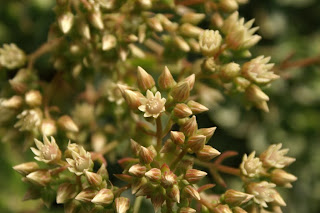
I have had this aeonium haworthii in the garden for aeons . . . ha ha. I don't rememb
 er where it came from, possibly an arboretum sale. You don't see the species in nurseries around here much if
er where it came from, possibly an arboretum sale. You don't see the species in nurseries around here much if  ever, although it's variety A. haworthii 'Kiwi' is pretty popular and well promoted in these days of saving water. The species is from the Canary Islands, another imported hardy plant that thrives in our trying-to-be-less-thirsty So Cal gardens.
ever, although it's variety A. haworthii 'Kiwi' is pretty popular and well promoted in these days of saving water. The species is from the Canary Islands, another imported hardy plant that thrives in our trying-to-be-less-thirsty So Cal gardens.My plant has grown large, verging on huge, a round ball about 3 feet in diameter. The stems underneath the canopy of foliage are brittle and have aerial roots all up and down them. I cut off part of the top last year, and new rosettes of
 leaves are growing out, starting a lower canopy. This plant is ridiculously easy to start from cuttings, just throw it on the ground somewhere and it will root and prosper.
leaves are growing out, starting a lower canopy. This plant is ridiculously easy to start from cuttings, just throw it on the ground somewhere and it will root and prosper.The bloom has just begun as you can tell from the numbers of unopened buds. These flowers attract lots of honeybees with their nectar.
There were also a
 few syrphid flies (these are Allograpta obliqua) nectaring at the flowers. The female syrphids can also be seen laying eggs
few syrphid flies (these are Allograpta obliqua) nectaring at the flowers. The female syrphids can also be seen laying eggs  on foliage nowadays. Their eggs will hatch into aphid-consuming maggots, so this group of flies is an important component of a balanced garden environment minimizing the need for pesticides.
on foliage nowadays. Their eggs will hatch into aphid-consuming maggots, so this group of flies is an important component of a balanced garden environment minimizing the need for pesticides.Making sure to plant plenty of nectar-producing flowers to provide food for these flies will enable them to thrive in your garden and help the ladybirds control your aphids; nectar flowers, it almost goes without saying, are essential for supporting those honeybees, as well.


1 comment:
Wonderful! You read my mind by ID'ing that syrphid fly for me. Even better to know they will pick up where the ladybirds left off.
Post a Comment